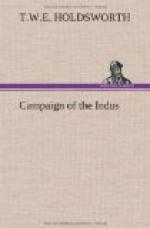I find I have not written since the last day I was at Cabool; and I have had few opportunities of doing so, as we have been on the move ever since, and until we reached Kelat there was very little to write about. We broke ground and marched to the other side of Cabool on Monday, the 16th of September, and halted on the 17th for a grand tomasha at the Bala Hissar, or Shah’s Palace, being no less than the investiture of the order of the Doorannee Pearl, which was conferred by Shah Shooja on the big-wigs of the army. Sir John Keane, Sir Willoughby Cotton, and Mr. Macnaghten get the first order; generals of divisions and brigadiers, the second; and all field officers engaged at Ghuzni and heads of departments, the third; for the rest, all officers engaged at Ghuzni get a gold medal, and the soldiers a silver one: however, all this depends on the will and sanction of Queen Victoria.
On Wednesday, the 18th, we took our final leave of Cabool and its beautiful environs, and reached Ghuzni on the 26th, where we halted two days, and then struck off in a new direction, straight across country to Quettah, by a new road, and very little known, leaving Candahar to our right, and thereby cutting off a considerable angle. Our object in doing this was, besides saving distance, to afford assistance, if required, to Captain Outram, who had preceded us by about a week, and was gone with some of the Shah’s force into the Ghiljee country, and was employed in destroying the forts, &c., of some of the refractory Ghiljee chiefs. He captured one fort in which were found forty or fifty fellows who were identified as being the same men who had murdered so many camp followers and some of our officers during our march through the country. I saw them at Ghuzni, where they were under confinement, and about to be executed in a few days, as I was told. About eight marches from Ghuzni, Outram sent to General Willshire for assistance, as his force was not sufficient; he was then before the largest of these hill forts, belonging to one of the most influential and refractory of the chiefs, and who had given us a great deal of annoyance in our way up. A wing of the 19th Native Infantry, some Artillery, and the Light Companies were therefore sent to his assistance; but they made a miserable failure as the chief, putting himself at the head of about a hundred faithful followers, dashed through their pickets at night, and made his escape with all his valuables, and without losing a man. We marched at an easy pace, detaching a force now and then to take a fort, which was invariably found, deserted on our approach. Nevertheless, we had hard work of it, as our route lay through and over high and barren mountains with scarcely an inhabitant or village to be seen, and nothing to be got for our cattle. For three days my horse, and those of most of us, lived on bushes and rank grass that we found occasionally. We had to depend on our commissariat for everything; and they found it difficult to supply grain for the




